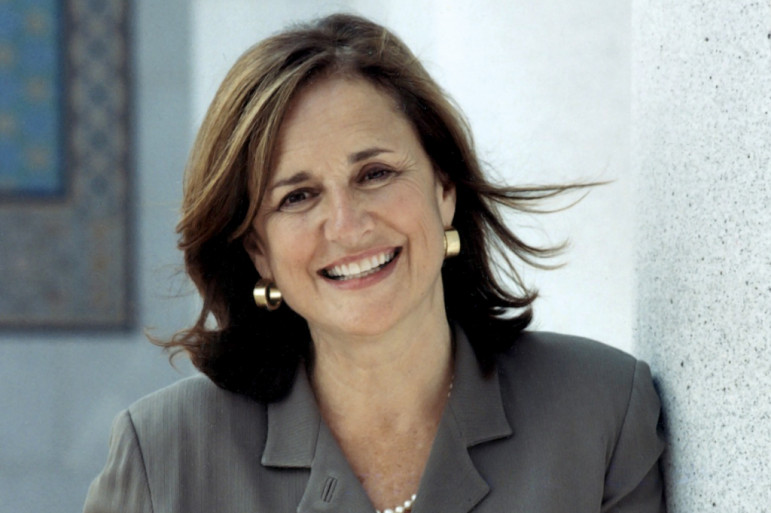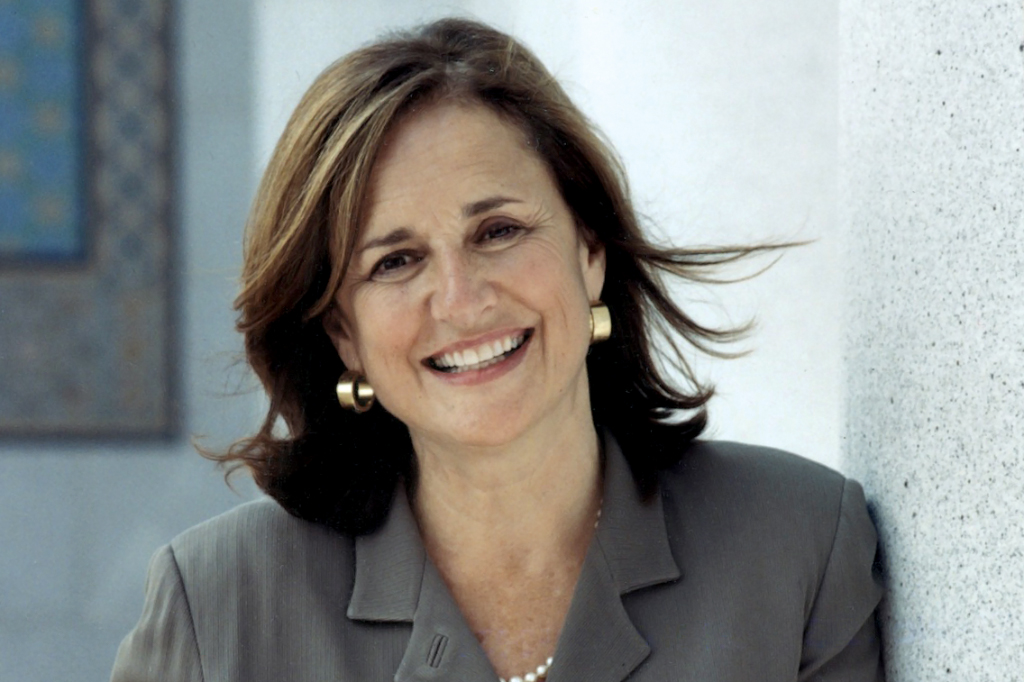
Barbara Grover
Under Carla Sanger’s leadership, LA’s BEST has grown from 10 schools and a $1 million annual budget in 1988 to 194 schools and a $40 million budget today.
See sidebar “LA’s BEST Serves up Innovative Smorgasbord of Fun, Learning“
Carla Sanger’s father, Harold Galperin, a beloved principal at Baltimore City’s largest elementary school in the 1950s, taught her some of the most important lessons about education when she was a little girl.
Sanger, a lifelong educator and a pioneering advocate for out-of-school programs, reflects on her father’s influence.
“He was the first to help me to understand that when you know the streets that the school’s located on, and you know the community, and you know the families and you know the children, you’re going to have much more engagement to create the culture and climate for children to learn,” Sanger said. “So my father was a prince among educators.”
Sanger has applied her father’s wisdom well in a career spanning more than 45 years, most recently as president and CEO of the acclaimed nonprofit LA’s BEST (Better Educated Students for Tomorrow) After School Enrichment Program in Los Angeles. Sanger, 69, announced in May she will retire from LA’s BEST at the end of November.
Before taking the helm at LA’s BEST in 1988, she worked as a public school teacher in Baltimore, co-founded a K-12 school in Bogota, Colombia, in 1969 (which is still open), did a stint as a curriculum writer, worked as the supervisor of day care services for the state of New Jersey and started an after-school program in Perth Amboy, in northern New Jersey.
Sanger, who recently won a lifetime achievement award in her field, recalls the roots of LA’s BEST: With parts of Los Angeles beset by drugs, poverty and violence in the late 1980s, then-Mayor Tom Bradley wanted a program that would keep kids safe in the critical hours between 3 p.m. and 6 p.m. — after school ends but before parents typically get home. Bradley appointed a 53-member education council, including educators, parents, executives, lawyers and activists.
The council – Sanger was a member — came up with LA’s BEST, a partnership among the city, the Los Angeles Unified School District (LAUSD) and the private sector. Sanger was chosen to lead the program, serving elementary school students.
Yet when the program started in 10 schools in 1988, Sanger was thoroughly unimpressed.
“My lens to assess the quality of any after-school program is: Would I put my kids here? Now, would I put my grandchildren here? And for the programs that I saw for LA’s BEST in that first September, the answer would have been, ‘No.’”
(Sanger and her husband, Academy Award-winning film producer Jonathan Sanger, have two sons and four grandchildren.)
In LA’s BEST debut year, she encountered a regimented after-school program with kids standing silently in single-file lines between activities at 4:30 p.m., and site coordinators — all credentialed teachers — who were either exhausted or “just didn’t seem like much fun.” Half the site coordinators burned out and left the program by the end of the first school year.
“There was just no humor. There was absolutely no humor,” Sanger recalls today.
So she went back to the mayor and education council and suggested LA’s BEST relax the requirement that site coordinators be credentialed teachers to attract a wider pool of potential staffers.
It worked.
Most of the credentialed teachers were replaced by young, part-time employees with little work experience. But they were great with kids, with training from LA’s BEST to help the recruits understand the need for social and emotional development of children and to communicate well with the students, their families and their communities.
This approach harkens back to the lessons Sanger learned about education from her father — and from her own years as a teacher in Baltimore at an elementary school in the late 1960s and at the after-school program she later started in New Jersey.
Lessons from her teaching days
As a teacher in Baltimore, Sanger recalls having about 45 students jammed into a single classroom, with no teacher’s aide, each of three years she taught there. Still, she tried to get to know all her pupils well — in the classroom, on the playground and after school, where she stayed until 6 p.m. every day and even taught some children to play guitar.
Such individual attention makes all the difference, Sanger said.
But even by early the 1970s, in New Jersey, she noticed some teachers bolting for the door when the school day ended, Sanger says.
Later, in L.A., she realized many teachers no longer lived in the crime-ridden neighborhoods where they taught and feared staying after school with their students.
Today, Sanger said, unions discourage L.A. teachers from devoting extra time to students in the cafeteria at lunchtime and on the playground.
“As far as I’m concerned, the playground is where you learn everything you needed to know about relating to each child,” Sanger said. “You learned who was a bully. You learned who was kind. You learned who was the star athlete. You learned even stories about what was going on in their families.”
Sanger is set to leave LA’s BEST as intense debate persists among educators, policymakers, parents and others: Should the traditional school day (or even the school year) be extended? Should the primary emphasis be on cognitive skills and should standardized tests be the best way to hold teachers and schools accountable for educating children in subjects such as reading, writing, science and math?
Or, as Sanger and LA’s BEST wonder, have we as a nation become too fixated on test scores and academic achievement at the expense of enrichment and education of the whole child? Should we focus more attention on what has been dubbed “expanded learning” outside the classroom — by providing experiences that are engaging and individualized and address the social, emotional and physical needs of children while making them better prepared to learn in the classroom?
Sanger said many programs that have extended the school day overemphasize remedial skills and cognitive development.
“You get a lot of rhetoric that says, ‘No, no, no, that’s not true. We’re going to use arts in our most cognitive-development areas.’ Well, I don’t want art to be used as a means toward cognitive development,” she said. “I want art to be used for art’s sake. I don’t want the physical activity to only happen insofar as one can calculate the batting average and make it a cognitive activity.
“I think we’ve lost our way when we try to align everything we do with something that ties to cognitive development in the regular school classrooms. We’ve absolutely missed the great opportunity of after-school if we don’t have a balance of education, enrichment, recreation and nutrition.”
The expanded learning approach has proved extraordinarily successful in L.A. and has been influential throughout the country.
From 10 Schools to 194
Sanger has shepherded LA’s BEST through astonishing growth, from 10 elementary schools with a $1 million annual budget in 1988 to 194 elementary schools and a $40 million budget today. The LAUSD, the nation’s second-largest school district behind New York City, serves more than 640,000 students at more than 900 schools.
LA’s BEST, a free after-school program, also offered at many sites in the summer, now provides about 29,000 kids each year with a rich array of experiences, and demand exceeds spots, as most of the program’s sites have waiting lists.
LA’s BEST has four key components:
- Homework: The program offers help with homework. In many LA’s BEST families, no one is home right after school to do so, while other families lack the English language skills to help kids with their homework.
- Cognitive development: This could be through science clubs, literacy clubs, technology — opportunities that engage thinking skills and problem-solving skills.
- Children’s choice: “If it’s not illegal, unethical, immoral or stupid, and the kids want to do it, we’re going to do it,” Sanger says. “That could include hip-hop. That could include basketball. That could include basket-weaving.”
- Nutrition: Children in LA’s BEST receive supper every school day.
Sanger’s work with LA’s BEST has drawn widespread praise.
This spring, she was recognized as one of the Top 25 Most Influential People in Afterschool by Afterschool Today magazine. And on April 30, Sanger was honored at the Best Out-of-School-Time (BOOST) Collaborative conference in Palm Springs, Calif. — the nation’s largest conference for after-school and out-of-school-time professionals — with a lifetime achievement award.
Sanger also played a pivotal role in achieving passage of California’s Proposition 49, which in 2002 created a $500 million annual funding stream for before- and after-school programs in the state.
Sanger, who holds a bachelor’s degree in English from the University of Pennsylvania and a master’s in education from Goucher College near Baltimore, also established Beyond the Bell, an umbrella office in the LAUSD that coordinates before- and after-school as well as Saturday programs in the city.
Michael Funk, director of the After School Division of the California Department of Education, is among many who praise Sanger’s work.
“Carla is definitely a person who really put after-school on the map in terms of its support to the educational system,” Funk said.
Funk had served more than five years with Sanger on a state before- and after-school advisory committee when he led an after-school program in San Francisco. He credits her with being a “pioneer,” instrumental in expanding the focus of such programs beyond the politically driven issue of kids’ safety to broaden it to a much more comprehensive approach.
Research from the University of California, Los Angeles, confirms LA’s BEST’s effectiveness.
A 2005 study found LA’s BEST participants were 20 percent less likely than non-participants to drop out of school, while a 2007 study showed participants were 30 percent less likely than non-participants to commit a juvenile crime.
A 2011 UCLA study found the longer participants had attended LA’s BEST, the bigger their gains in middle school math, language arts, science and history. UCLA researchers also found in 2011 LA’s BEST participants scored higher than non-participants on second- and third-grade standardized math tests. And by middle school, those who had attended LA’s BEST achieved higher GPAs and had better attendance than those who had not attended the program.
All of which shows the lessons of expanded learning should be applied at schools nationwide, Sanger said.
If she had her way, every school in the country would be required to stay open until 6 p.m., and every principal would be required to identify a community partner to run an after-school program.
No doubt, her late father, the one-time principal extraordinaire, would see the merits of doing so.
Said Sanger: “There’s never before in the history of this country been so few adults at home after school. Nobody’s home to help kids grow, and I think that if we’re looking at a democracy and preserving democracy — which to me is the primary goal of education — we’re going to lose our way if we don’t understand how important it is to keep kids after school.”
See sidebar “LA’s BEST Serves up Innovative Smorgasbord of Fun, Learning“
































